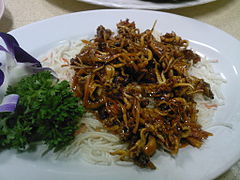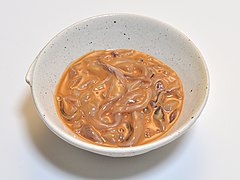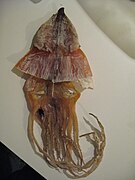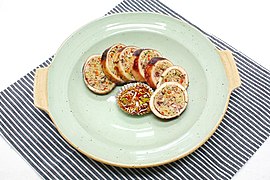Squid as food
This article needs additional citations for verification. (December 2007) |

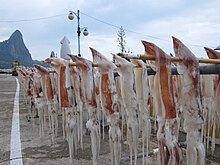
Squid is eaten in many cuisines; in English, the culinary name calamari is often used for squid dishes.[1] There are many ways to prepare and cook squid. Fried squid is common in the Mediterranean. In New Zealand, Australia, the United States, Canada, and South Africa, it is sold in fish and chip shops, and steakhouses. In Britain, it can be found in Mediterranean 'calamari' or Asian 'salt and pepper fried squid' forms in various establishments, often served as a bar snack, street food, or starter.
Squid can be prepared for consumption in a number of other ways. In Korea and Japan, it is sometimes served raw, and elsewhere it is used as sushi, sashimi and tempura items, grilled, stuffed, covered in batter, stewed in gravy and served in stir-fries, rice, and noodle dishes. Dried shredded squid is a common snack in some Asian regions, including East Asia.
Use
The body (mantle), arms, tentacles, and ink of squid are all edible; the only parts of the squid that are not eaten are its beak and gladius (pen). The mantle can be stuffed whole, cut into flat pieces or sliced into rings.
Asia
In
In China, Thailand, and Japan squid is grilled whole and sold in food stalls.
Pre-packaged dried shredded squid or cuttlefish are snack items in Hong Kong, Taiwan, Korea, Japan, China and Russia, often shredded to reduce chewiness.
Japan
In Japan, squid is used in almost every type of dish, including sushi, sashimi, and tempura. It can also be marinated in soy sauce (ika okizuke), stewed (nabemono), and grilled (ikayaki). It is eaten raw as ika sōmen.
Korea
In Korea, squid is sometimes killed and served quickly. Unlike octopus, squid tentacles do not usually continue to move when reaching the table. This fresh squid is 산 오징어 (san ojingeo) (also with small octopuses called nakji). The squid is served with Korean mustard, soy sauce, chili sauce, or sesame sauce. It is salted and wrapped in lettuce or perilla leaves. Squid is also marinated in hot pepper sauce and cooked on a pan (nakji bokum or ojingeo bokum/ojingeo-chae-bokkeum). They are also served by food stands as a snack food, battered and deep fried or grilled using hot skillets. They are also cut up into small pieces to be added to 해물파전 (Korean seafood pancake) or a variety of spicy seafood soups. Dried squid may also accompany alcoholic beverages as anju. Dried squid is served with peanuts. Squid is roasted and served with hot pepper paste or mayonnaise as a dip. Steamed squid and boiled squid are delicacies.
Also in Korea, squid is made into
Philippines
In the
South Asia
In India and Sri Lanka, squid or cuttlefish is eaten in coastal areas for example, in Kerala and Tamil Nadu. Squid are eaten deep fried (Koonthal Fry) or as squid gravy (koonthal varattiyathu/Roast). In Kerala and Tamil Nadu, squid is called koonthal, kanava or kadamba. In Coastal Karnataka, squid is also called bondaas.
Middle East
In Egypt, Cyprus, and Turkey, squid rings and arms are coated in batter and fried in oil. Other recipes from these regions simmer squid with vegetables.[2] Squid is also often stuffed.
In Lebanon, Syria, Turkey, fried squid is served with
Europe
Southern Europe
Fried squid (calamari fritti) is a dish in Mediterranean cuisine, consisting of batter-coated, deep-fried squid (fried for less than two minutes to prevent toughness), which is served plain, with salt and lemon on the side.
In Spain, (rabas or calamares a la romana, battered calamari, lit. Roman-style calamari) has the calamari rings covered in a thick batter, deep fried and served with lemon juice and mayonnaise or aioli. Traditionally in Cantabria and the Basque Country rabas are cut into straight strips rather than rings.[3] Battered and fried baby squid is known as puntillitas. Squid stewed in its own black ink is called calamares en su tinta or chipirones en su tinta, resulting in a black stew-like dish in which squid meat is very tender and is accompanied by a thick black sauce, usually made with onion, tomato and squid ink, among others.
In Spain and
In Spain, Italy, Greece, Cyprus, Turkey, Portugal, Slovenia and Croatia, squid rings and arms are coated in batter and fried in oil. Other recipes from these regions feature squid (or octopus) simmered slowly, with vegetables such as squash or tomato. When frying, the squid flesh is kept tender due to a short cooking time; when simmering, the flesh is most tender when cooking is prolonged with reduced temperature. In Greece or Cyprus it is served also with tzatziki, a Greek yoghurt, cucumber and mint dip.
In Sardinia, squid are served with a sauce made from lemon, garlic, parsley, and olive oil.
In
In Malta, klamar mimli involves stuffing the squid with rice, breadcrumbs, parsley, garlic and capers and then gently stewing in red wine.
In Slovenia, squid are eaten grilled and stuffed with pršut and cheese, with blitva (Swiss chard).
Russia
In Russia, a lightly boiled julienned squid with onion rings, garnished with mayonnaise, makes a salad. Another dish is a squid stuffed with rice and vegetables and then roasted.
Commonwealth
In
North America
In North America, fried squid is a staple in seafood restaurants. It is served as an
In the United States, in an attempt to popularize squid as a protein source in the 1970s, researchers at Massachusetts Institute of Technology developed a squid-gutting machine, and submitted squid cocktail, rings, and chowder to a 70-person tasting panel for market research.[6][7] Despite a general lack of popularity of squid in the United States, as aside from the internal "ethnic market" polling had shown a negative public perception of squid foods,[8] the tasting panel gave the dishes "high marks".[9][10]
During the 2020 Democratic National Convention, calamari was featured prominently during the virtual roll call for the state of Rhode Island.[11]
Etymology
The English name calamari comes from the Italian calamari (plural of calamaro), Spanish calamar, and Modern Greek καλαμάρι kalamári.[1] Ultimately, all of these terms derive from the Late Latin calamarium, "pen case" or "ink pot", itself from the Latin calamarius, "pertaining to a writing-reed", after the resemblance in shape and the inky fluid that squid secrete; calamarius in turn derives from the Greek κάλαμος kalamos 'reed' or 'pen'.[1][12][13][14][15][16]
Nutritional value
The nutritional value of squid compares favorably with fish, being high in protein and phosphorus with trace amounts of calcium, thiamine, and riboflavin.
Allergies
Gallery
-
Chinese-style fried baby squid
-
Japanese Ikameshi
-
JapaneseIka Sōmen(squid noodle)
-
Japanese sushi
-
Japanese Ika no shiokara
-
Squid steaks, uncooked
-
Squid jerky
-
Korean ojingeo-jeot (salted squid)
-
Korean ojingeo-sundae(stuffed squid)
-
Korean Ojingeo-Twigim along with Gochu-Twigim. Ojingeo is squid whereas Gochu is pepper
See also
References
- ^ a b c Oxford English Dictionary, 3rd edition, 2002, s.v.
- ISBN 978-0-85786-856-5.
- ^ "The Complete Foodie Guide to Cantabria and the Basque Country". Great British Chefs. 2022-10-27. Retrieved 2023-01-13.
- ^ "Choco frito 'à setubalense'". jornalsabores.com. 9 January 2019. Retrieved 27 December 2020.
- Salon. Retrieved 1 September 2014.
- ^ Aquatic Sciences and Fisheries Abstracts, Vol. 4. 1974 – via Google Books.
- ^ "Could Squid Fishery Boom?". NOAA Update. NOAA Magazine. Vol. 4, no. 4. National Oceanic and Atmospheric Administration. October 1974. p. 70 – via Google Books.
- ISBN 9780870552496– via Google Books.
- ^ "Fishy Thinking". New Scientist. 21 March 1974. p. 764 – via Google Books.
- ^ Bronwyn Hurd (1974). Using the Seas to Serve People: A Report on the Massachusetts Institute of Technology Sea Grant Program, 1 July 1973 to 30 June 1974 (Report) – via Google Books.
- ^ Barone, Vincent (2020-08-19). "Rhode Island's DNC roll call for Biden prominently features plate of calamari". New York Post. Retrieved 2020-08-19.
- ^ Harper, Douglas. "calamari". Online Etymology Dictionary.
- Perseus Project.
- Dictionary of Modern Greek] (in Greek).
- ^ Beekes, Robert (2010). "κάλαμος". Etymological Dictionary of Greek. Leiden Indo-European Etymological Dictionary Series. With the assistance of Lucien van Beek. Brill.
- Perseus Project.
- ^ Kalikstein, Paul H. (1974). The Marketability of Squid MIT Report No. MITSG 74-24. Massachusetts Institute of Technology. p. 9-10.; citing Veteikis, J.J. (June 1966). "Commercial Fishing for Squid". Australian Fisheries Newsletter. No. 25. Fisheries Branch, Dept. of Primary industry, Australia.
- ^ "calamari". Nutrition Value of Squid As Food For Human. 2003.
- ^ "Squid (Loligo loligo): The new source to extract omega-3 and omega-6 rich marine oils" (PDF). Nutrition Value of Squid As Food For Human. 2016.
- ^ "Sea Food Allergy". Allergy Society of South Africa. Archived from the original on 2010-04-02. Retrieved 2010-07-04.
- ^ Auckland Allergy Clinic, "Seafood Allergy" Archived 2011-08-03 at the Wayback Machine
External links
 Media related to Squid as food at Wikimedia Commons
Media related to Squid as food at Wikimedia Commons






